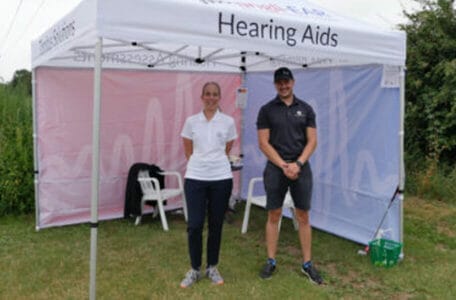Hearing aids are designed with four integral parts: microphone, processor, receiver and power source. These elements all work together to pick up sounds, improve the signal, send information to the receiver and deliver it to our ears – all powered by a battery.
In recent years, hearing aids have significantly improved their functionality, so that even today’s ‘basic’ devices are a vast improvement on those that came before.
As technology improves, hearing aids can do even more to help you hear – for example, they can be adjusted to suit your needs and your listening environment. Whether you choose a basic or advanced model, today’s hearing aids offer plenty of ways to help you live well with hearing loss.
Improved sound processing means that hearing aids can categorise sections of sound before it’s digitised – so they can be adapted to suit your type of hearing loss. For example, you may have high frequency hearing loss so your hearing aid can amplify sounds which are of that frequency, rather than amplifying everything all at once!
Many new hearing aids are also Bluetooth compatible, so that they can be connected to mobile phones and other suitable devices. The service is available through wireless technology which can improve sound quality and eliminate other noise, interference from other devices or feedback from the microphone.
Some of the latest advanced hearing aids now feature Artificial Intelligence (AI) which enables them to learn how your brain would hear sound if you didn’t have hearing loss. It can also make automatic changes based on your initial choice of volume or environmental settings, which allows them to adapt more quickly to each listening situation.
Many of today’s hearing aids can be paired with smartphone apps, allowing you to make your own adjustments; monitor the battery level and ask an audiologist for advice. These devices are also able to stream phone calls directly to the hearing aid.
Rechargeable batteries are increasingly used with hearing aids now, eliminating the need to replace them every few weeks. These are much more convenient for the user and better for the environment, as there is less waste.
If you suffer from tinnitus, some of the more advanced hearing aids can produce sounds which lessen the effects of the ‘ringing’ sensation in your ears. Many people with tinnitus find that simply amplifying the sounds that they need to hear helps to block out these intrusive other sounds, which minimises any negative effects.
Basic digital hearing aids can be programmed but will have limited adjustments available for your particular type of hearing loss. You will also need to make some adjustments on your own to suit the environment that you’re in, such as volume control or reducing the impact of other noises. In general terms, most basic hearing aids now include:
Wireless technology
With this level of tech, the sound received by two hearing aids is shared and processed to give you the best level of hearing, depending on your situation. This is ‘binaural processing’ which copies the brain’s ability to process information coming from both ears. Wireless hearing aids can also communicate with other devices (usually via Bluetooth) such as Telecoils that work with hearing loops, frequency modulation (FM) systems and smartphones (see below).
Telecoil
Another wireless feature, Telecoil (or ‘tcoil’) can pick up electromagnetic signals from compatible telephones or rooms with a hearing loop. As the microphone isn’t needed to process sound, unwanted noise and feedback can be eliminated. Telecoils are useful for listening to public performances, concerts, exhibitions, and religious services.
FM compatibility
Hearing aids with this facility can connect with FM systems to improve the quality of sound you receive, with less interference. This is an important feature for children with hearing loss. as it helps them to hear the voice of their teacher above all the other sounds in the classroom.
Directional microphone systems
These can boost sounds coming from in front of you, while reducing sounds coming from other directions. This can help people with hearing loss hold a conversation while there’s also background noise present.
Digital noise reduction
This function analyses sound signals and reduces the level of unwanted noise. Many hearing aid wearers prefer to have this technology because it reduces the stress caused by background or other environmental noise.
Impulse noise reduction
This can improve listening comfort by detecting and softening any extra distracting background noises, such as rattling, tapping or clicking. This feature is usually found on the higher spec hearing aid model alongside the next in our list…
Wind noise reduction
Very useful for people who enjoy sports and outdoor activities, this function can detect and reduce the impact of wind blowing across the hearing aid microphone.
Feedback management systems
Sometimes feedback causes a horrible whistling noise in the hearing aid, which can be very uncomfortable for the wearer. With the management system in place, amplification can be reduced which stops the whistling (more advanced devices stop the whistling without affecting any amplification).
Data logging
The very latest in modern hearing aids can also include a feature which stores your preferred volume levels and other bespoke functions to help your hearing loss. Your audiologist can also access the data, which is useful for follow up appointments and customising your hearing aid fittings.
Hearing aid technology has advanced greatly in recent years, enabling the wearer to enjoy conversations, social situations and other environments where they can listen to the sounds that they want to hear, without suffering from distractions or anxiety.
As an independent audiology clinic, we are pleased to be able to offer the best hearing aid devices from across a variety of premium healthcare brands. Our priority is to provide the most suitable hearing aid for our clients and at the right price.
To find out more about our hearing aids visit angli-EAR Hearing Aids or call us on 01223 661399.




